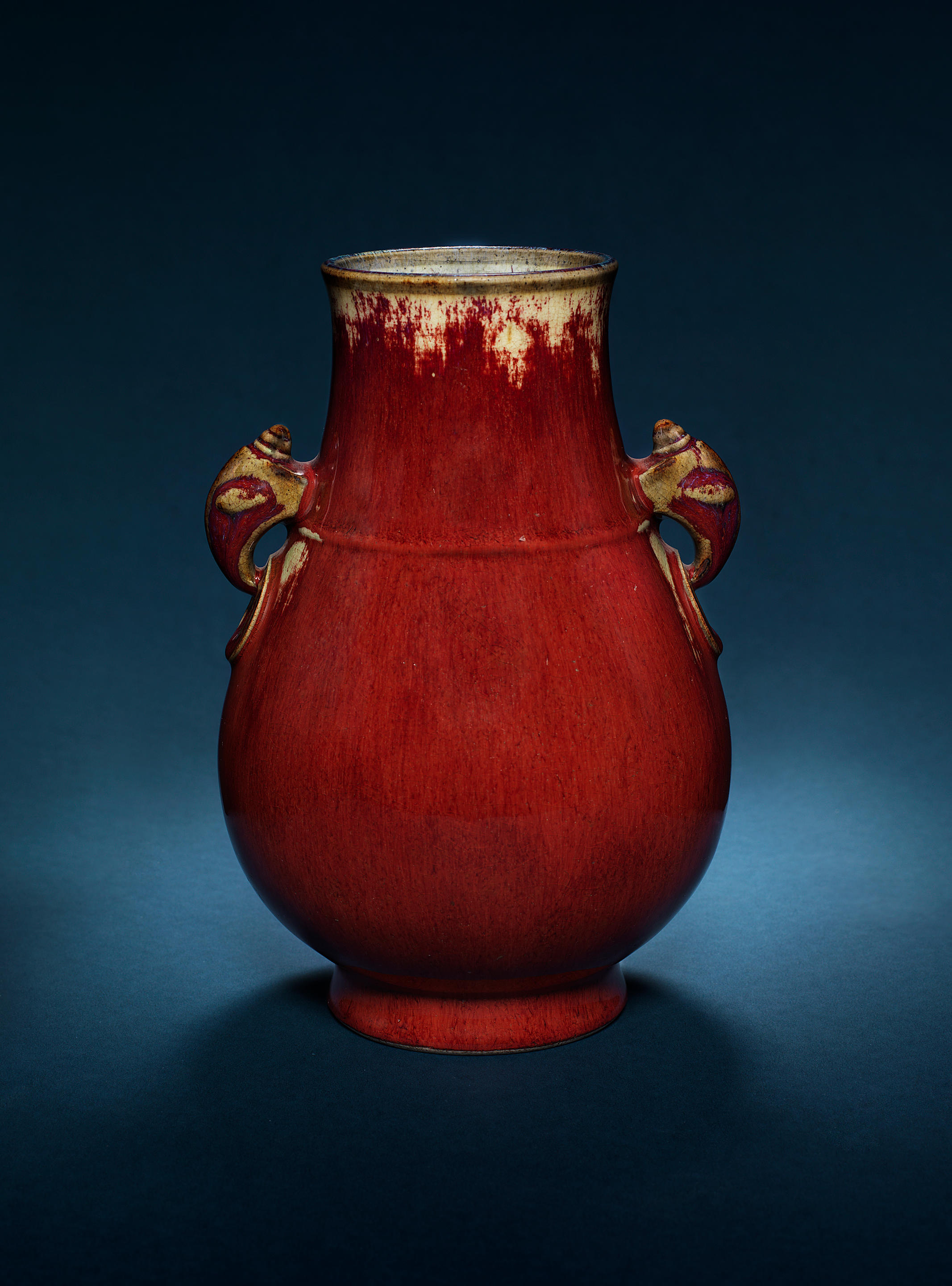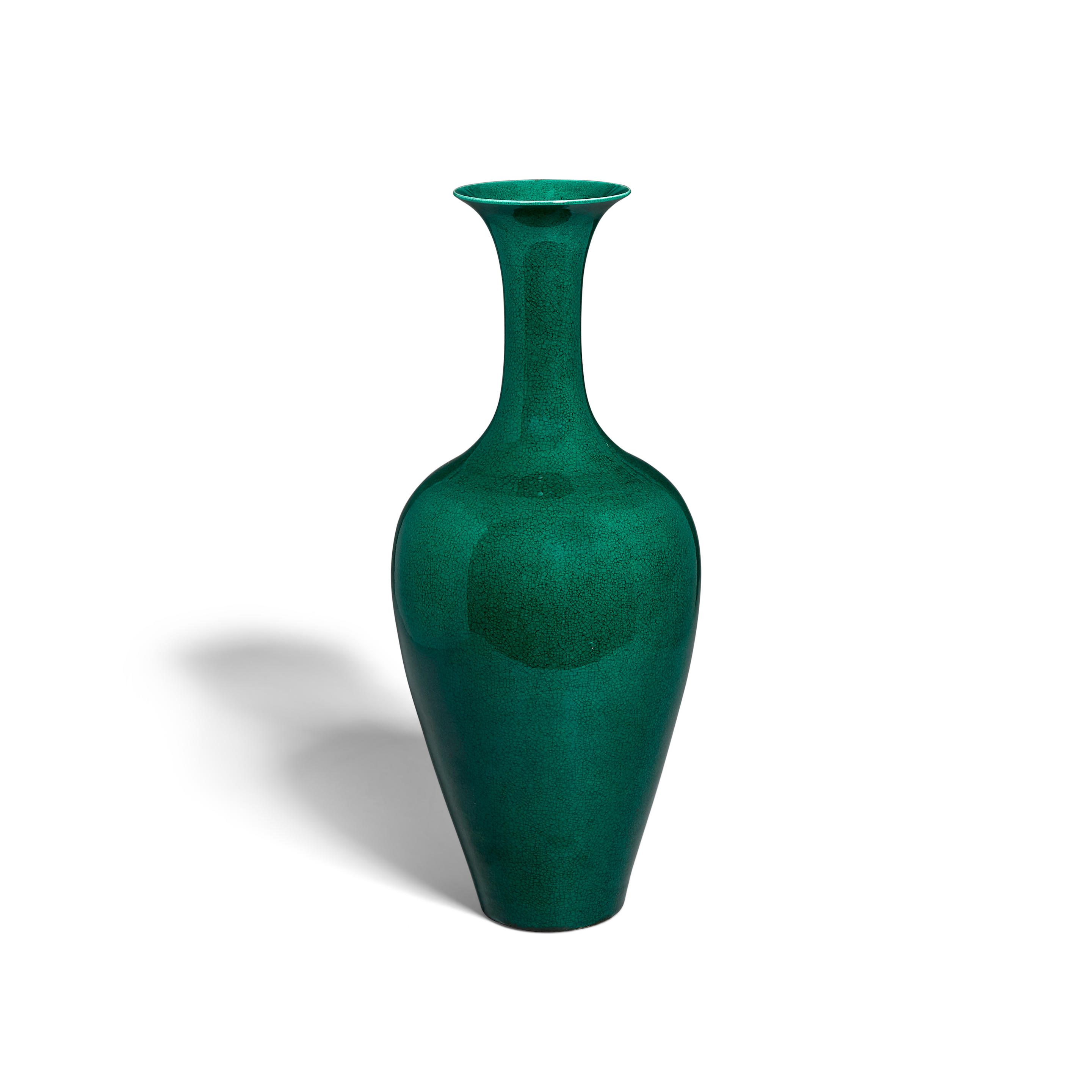China, 1736-1795. Well potted with an oviform body rising to a short cylindrical neck, covered overall with a finely crackled and rich purplish-blue glaze with lavender streaks thinning to mushroom around the rim, the base covered in a mushroom-brown wash and incised with a six-character seal mark da Qing Qianlong nianzhi and of the period. Provenance: Private collection in Melbourne, Australia, and thence by descent in the same family to the present owner. Condition: Excellent condition with minor wear and firing irregularities, some dark spots to interior, few microscopic glaze flakes near the foot. The inside of the vessel bears significant glaze calcification to its lower half, probably resulting from extensive use as a vase. Weight: 530.7 g Dimensions: Height 13.8 cm Vessels covered in the striking flambé glaze reflect the Yongzheng and Qianlong Emperors' predilection for Song dynasty Jun wares. It was the Yongzheng Emperor who first commissioned the development of new glazes in imitation of Jun vessels and a total of nine different types of revival Jun glazes were created, which can be found recorded in the 1732 edition of the Jiangxi tongzhi [General Description of the Jiangxi Province]. The seal mark on the base of this vase is also notable. A similar mark is discussed by Peter Y. K. Lam in ‘Four Studies on Yongzheng and Qianlong Imperial Ware’, in Ethereal Elegance, Porcelain Vases of the Imperial Qing, Art Museum, The Chinese University of Hong Kong, 2007, pages 55 and 56, where the author notes the similarity of this mark with a group of monochrome and ritual wares. According to Palace records, these would have been produced before or in the 13th year of the Qianlong reign, corresponding to 1748. Expert’s note: When comparing the glaze of the present vase with that of the Jeffrey Moy meiping at Sotheby’s (see Auction result comparison), the remarkable similarities are most apparent when we focus on the lower section around the foot rim (see fig. 1), where the thin trimming line of deep burgundy color, the distinct and fine crackle to the glaze, and the body as revealed by the unglazed foot rim can leave no doubt as to their close relation. Further signs include the brown wash above the incised six-character Qianlong seal mark as well as the glaze thinning to mushroom around the rim, also clearly indicating that the present lot and the meiping are – as Peter Y. K. Lam noted in 2007 – from a group of monochrome and ritual wares that, according to Palace records, would have been produced in or before 1748. Auction result comparison: Compare a teadust-glazed oviform vase of closely related size and identical form, also with a Qianlong seal mark and of the period, at Christie’s Hong Kong in The Imperial Sale / Important Chinese Ceramics & Works of Art on 1 June 2016, lot 3218, sold for HKD 1,840,000. Compare also a related flambé-glazed vase, of similar form and slightly larger size, with a Yongzheng seal mark and of the period, at Sotheby’s London in Fine Chinese Ceramics and Works of Art on 16 May 2012, lot 174, sold for GBP 73,250. Compare also with a related flambé-glazed meiping from the collection of Jeffrey Moy, with a very similar glaze and also with an incised Qianlong seal mark and of the period, at Sotheby’s Hong Kong, in Emperors’ Playthings – A Connoisseur’s Collection, on 6 April 2016, lot 3010, sold for HKD 4,280,000. Literature comparison: Compare a closely related but larger (20.3 cm high) flambé glazed ovoid vase, also with a Qianlong seal mark and of the period, sold at Christie’s New York, 19 September 2006, lot 368. 乾隆款及年代罕見窯變釉小瓶 中國,1736-1795年。厚胎,微縮頸,鼓腹,瓶身施精細的藍紫色開片窯變釉,在邊緣變薄,底部棕色釉並可見 “大清乾隆年製”六字款。 來源:澳大利亞墨爾本私人收藏, 在同一家族保存至現任藏家。 品相:狀況良好,輕微磨損和燒製不規則,瓶內有一些黑點,足部附近很些微小的釉面開片。瓶內下半部分有明顯的釉質鈣化,可能是由於經常被當作花瓶所致。 重量:530.7 克 尺寸:高13.8 厘米 拍賣結果比較:一件 茶葉末釉瓶,同樣形狀和相近尺寸,乾隆款與年代,見香港佳士得 The Imperial Sale / Important Chinese Ceramics & Works of Art 2016年6月1日 lot 3218, 售價HKD 1,840,000. 另一件相似形狀,但尺寸更大的窯變釉瓶,雍正款與年代,見倫敦蘇富比 Fine Chinese
China, 1736-1795. Well potted with an oviform body rising to a short cylindrical neck, covered overall with a finely crackled and rich purplish-blue glaze with lavender streaks thinning to mushroom around the rim, the base covered in a mushroom-brown wash and incised with a six-character seal mark da Qing Qianlong nianzhi and of the period. Provenance: Private collection in Melbourne, Australia, and thence by descent in the same family to the present owner. Condition: Excellent condition with minor wear and firing irregularities, some dark spots to interior, few microscopic glaze flakes near the foot. The inside of the vessel bears significant glaze calcification to its lower half, probably resulting from extensive use as a vase. Weight: 530.7 g Dimensions: Height 13.8 cm Vessels covered in the striking flambé glaze reflect the Yongzheng and Qianlong Emperors' predilection for Song dynasty Jun wares. It was the Yongzheng Emperor who first commissioned the development of new glazes in imitation of Jun vessels and a total of nine different types of revival Jun glazes were created, which can be found recorded in the 1732 edition of the Jiangxi tongzhi [General Description of the Jiangxi Province]. The seal mark on the base of this vase is also notable. A similar mark is discussed by Peter Y. K. Lam in ‘Four Studies on Yongzheng and Qianlong Imperial Ware’, in Ethereal Elegance, Porcelain Vases of the Imperial Qing, Art Museum, The Chinese University of Hong Kong, 2007, pages 55 and 56, where the author notes the similarity of this mark with a group of monochrome and ritual wares. According to Palace records, these would have been produced before or in the 13th year of the Qianlong reign, corresponding to 1748. Expert’s note: When comparing the glaze of the present vase with that of the Jeffrey Moy meiping at Sotheby’s (see Auction result comparison), the remarkable similarities are most apparent when we focus on the lower section around the foot rim (see fig. 1), where the thin trimming line of deep burgundy color, the distinct and fine crackle to the glaze, and the body as revealed by the unglazed foot rim can leave no doubt as to their close relation. Further signs include the brown wash above the incised six-character Qianlong seal mark as well as the glaze thinning to mushroom around the rim, also clearly indicating that the present lot and the meiping are – as Peter Y. K. Lam noted in 2007 – from a group of monochrome and ritual wares that, according to Palace records, would have been produced in or before 1748. Auction result comparison: Compare a teadust-glazed oviform vase of closely related size and identical form, also with a Qianlong seal mark and of the period, at Christie’s Hong Kong in The Imperial Sale / Important Chinese Ceramics & Works of Art on 1 June 2016, lot 3218, sold for HKD 1,840,000. Compare also a related flambé-glazed vase, of similar form and slightly larger size, with a Yongzheng seal mark and of the period, at Sotheby’s London in Fine Chinese Ceramics and Works of Art on 16 May 2012, lot 174, sold for GBP 73,250. Compare also with a related flambé-glazed meiping from the collection of Jeffrey Moy, with a very similar glaze and also with an incised Qianlong seal mark and of the period, at Sotheby’s Hong Kong, in Emperors’ Playthings – A Connoisseur’s Collection, on 6 April 2016, lot 3010, sold for HKD 4,280,000. Literature comparison: Compare a closely related but larger (20.3 cm high) flambé glazed ovoid vase, also with a Qianlong seal mark and of the period, sold at Christie’s New York, 19 September 2006, lot 368. 乾隆款及年代罕見窯變釉小瓶 中國,1736-1795年。厚胎,微縮頸,鼓腹,瓶身施精細的藍紫色開片窯變釉,在邊緣變薄,底部棕色釉並可見 “大清乾隆年製”六字款。 來源:澳大利亞墨爾本私人收藏, 在同一家族保存至現任藏家。 品相:狀況良好,輕微磨損和燒製不規則,瓶內有一些黑點,足部附近很些微小的釉面開片。瓶內下半部分有明顯的釉質鈣化,可能是由於經常被當作花瓶所致。 重量:530.7 克 尺寸:高13.8 厘米 拍賣結果比較:一件 茶葉末釉瓶,同樣形狀和相近尺寸,乾隆款與年代,見香港佳士得 The Imperial Sale / Important Chinese Ceramics & Works of Art 2016年6月1日 lot 3218, 售價HKD 1,840,000. 另一件相似形狀,但尺寸更大的窯變釉瓶,雍正款與年代,見倫敦蘇富比 Fine Chinese
.jpg)
.jpg)













Try LotSearch and its premium features for 7 days - without any costs!
Be notified automatically about new items in upcoming auctions.
Create an alert